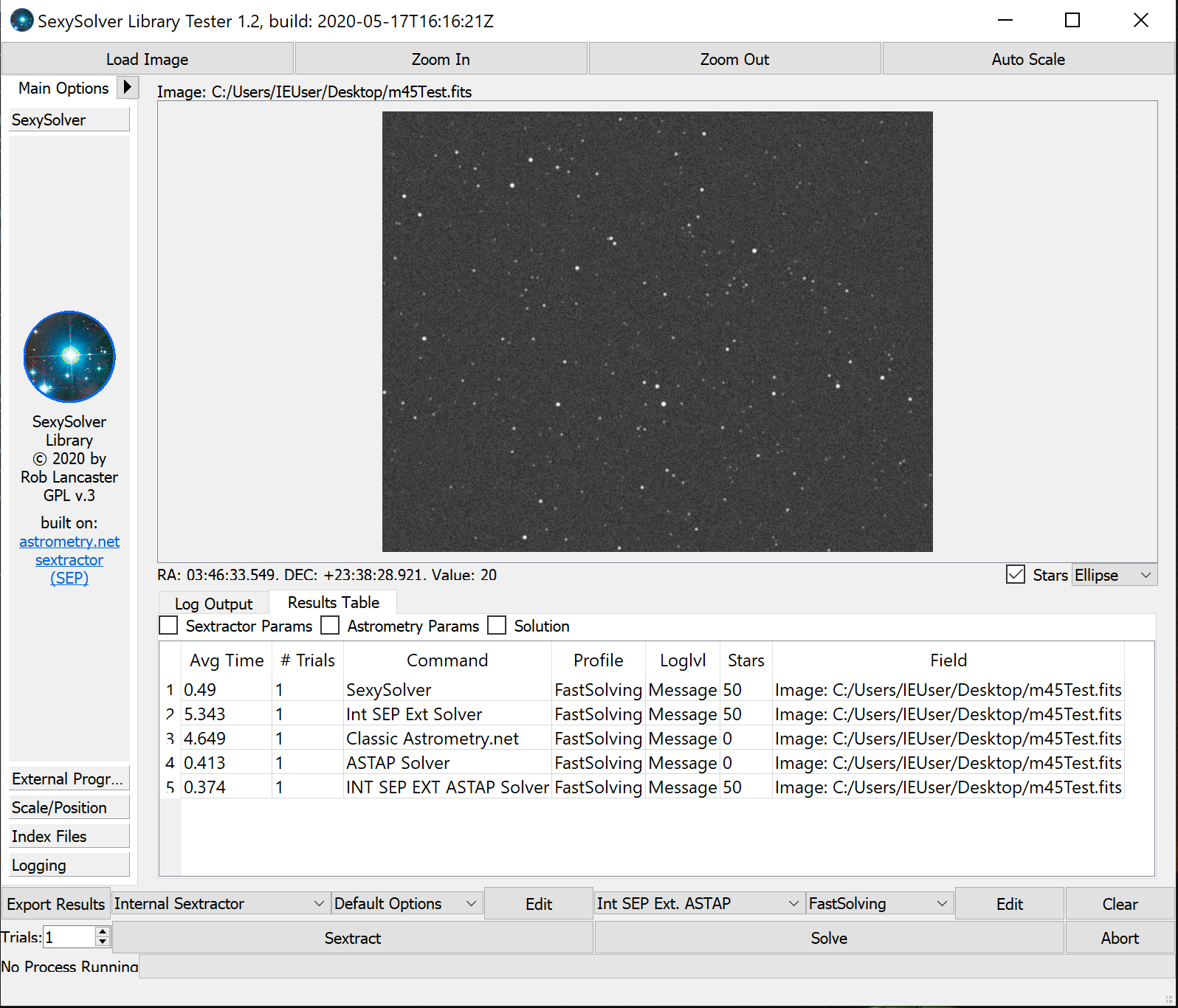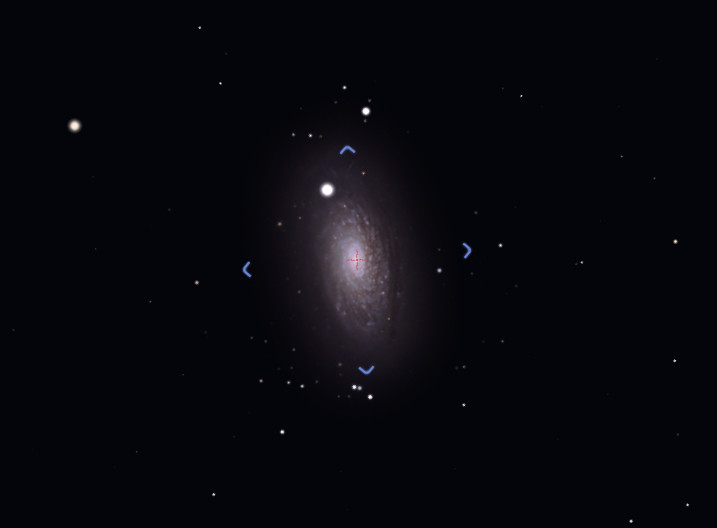INDI Library v2.0.7 is Released (01 Apr 2024)
Bi-monthly release with minor bug fixes and improvements
New Internal Solver for Mac, Windows, and Linux -- Testing/ Experiments needed
- Rob Lancaster
-
 Topic Author
Topic Author
- Offline
- Supernova Explorer
-

- Posts: 2877
- Thank you received: 812
Replied by Rob Lancaster on topic New Internal Solver for Mac, Windows, and Linux -- Testing/ Experiments needed
ASTAP does perform very well when the information about the image is pretty well known and as you say 99% of solving is like this. But there are still images that do solve with astrometry.net and don't solve with ASTAP (particularly ones from jpeg images and other totally blind solves) and astrometry.net used to take ages and ages to solve these types of images. I think with the optimizations that I have made in this program, we can really address the blind solve problem astrometry.net has.
As of now, I would say the best idea is that you know your image position and scale fairly closely, use INT SEP EXT ASTAP using the FastSolving profile. If you don't know your image information well and are doing a totally blind solve, use the SexySolver and one of the Parallel profiles. (ideally the small scale one or large scale one depending on whether you are using a telescope or a just a camera lens.)
Please Log in or Create an account to join the conversation.
- Rob Lancaster
-
 Topic Author
Topic Author
- Offline
- Supernova Explorer
-

- Posts: 2877
- Thank you received: 812
Replied by Rob Lancaster on topic New Internal Solver for Mac, Windows, and Linux -- Testing/ Experiments needed
github.com/rlancaste/sexysolver-tester/releases/tag/1.3
Please Log in or Create an account to join the conversation.
Replied by han on topic New Internal Solver for Mac, Windows, and Linux -- Testing/ Experiments needed
I'm glad you have it running. I think the IN SEP routine could present a benefit for images which suffer from poor guiding so oval stars. ASTAP will ignore oval stars as galaxies/close doubles.
Note also that less stars makes it much faster. The 500 stars is normally a maximum. It will also work with 200 or 100 stars and will be much faster. This will happen automatically for short exposures (5 seconds) Then ASTAP will be very fast and scan an area with a radius of 30 degrees in 20 or 30 seconds. If I remember well the ASTAP routine will skip stars with a SNR below 6 to prevent too much noise in the signal. The minimum amount of stars is maybe 30 or 40. Theoretical the bare minimum is 12 stars. The FITS table input is not limited, so you have to reduce it in IN SEP.
The image scale tolerance (FOV) is about plus minus 40% but the reliability of detecting become less. ASTAP gives a warning if the scale is 5 percent off.
It also needs some resolution. As minimum resolution, I recommend 1280x960 pixels. Maybe with IN SEP it's get better but that requires testing. Solving works maybe down till 800x600 pixels.
It would like to test the performance also for some larger offsets. I think it is now limited in your program at 15 degrees.
Cheers, Han
Please Log in or Create an account to join the conversation.
- Rob Lancaster
-
 Topic Author
Topic Author
- Offline
- Supernova Explorer
-

- Posts: 2877
- Thank you received: 812
Replied by Rob Lancaster on topic New Internal Solver for Mac, Windows, and Linux -- Testing/ Experiments needed
It is not limited to 15 degrees by the way, that is just the default and the setting in all the profiles I have made. You can change that in the profile editor under the astrometry settings
Please Log in or Create an account to join the conversation.
- Richard Beck
-

- Offline
- Elite Member
-

- Posts: 185
- Thank you received: 28
Replied by Richard Beck on topic New Internal Solver for Mac, Windows, and Linux -- Testing/ Experiments needed
I thought I would try a difficult solve.
I cropped from a Stellarium screenshot of M63 at my imaging FOV (+/-) and fed the jpeg to SexySolverTester 1.3.
Using the internal solver with Parallel Small scale, the image was correctly solved in 0.728s. SexySolverTester using the ASTAP solver failed.
I tried to solve in ASTAP directly and got theses messages in the header section:
COMMENT 1 Written by ASTAP, Astrometric STAcking Program. www.hnsky.org
PLTSOLVD= F / No plate solution found.
WARNING = 'Warning, too small image!! 'Please Log in or Create an account to join the conversation.
Replied by han on topic New Internal Solver for Mac, Windows, and Linux -- Testing/ Experiments needed
It's too artifical. ASTAP can't do miracles
Please Log in or Create an account to join the conversation.
- Rob Lancaster
-
 Topic Author
Topic Author
- Offline
- Supernova Explorer
-

- Posts: 2877
- Thank you received: 812
Replied by Rob Lancaster on topic New Internal Solver for Mac, Windows, and Linux -- Testing/ Experiments needed
Please Log in or Create an account to join the conversation.
Replied by han on topic New Internal Solver for Mac, Windows, and Linux -- Testing/ Experiments needed
sourceforge.net/projects/astap-program/f...r/astap.pkg/download
No change for Linux and Windows. Only available at :
www.hnsky.org/astap_setup.exe
www.hnsky.org/astap_amd64.deb
I need some more testing before I release these two to Sourceforge.
Han
Please Log in or Create an account to join the conversation.
- Rob Lancaster
-
 Topic Author
Topic Author
- Offline
- Supernova Explorer
-

- Posts: 2877
- Thank you received: 812
Replied by Rob Lancaster on topic New Internal Solver for Mac, Windows, and Linux -- Testing/ Experiments needed
Please Log in or Create an account to join the conversation.
Replied by han on topic New Internal Solver for Mac, Windows, and Linux -- Testing/ Experiments needed
Please Log in or Create an account to join the conversation.
- Ronald Scotti
-

- Offline
- Elite Member
-

- Posts: 396
- Thank you received: 17
Replied by Ronald Scotti on topic New Internal Solver for Mac, Windows, and Linux -- Testing/ Experiments needed
Just getting started with this. I am running on an Rpi4 with a 32G SD card. I have a 'slow' imaging setup; CSCT 9.25 at f/10 with an SBIG 8300M camera. My FOV is 20' x 26' , I run the PA routine in Ekos and I use Astrometry.net to do the solves and they usually solve in a minute or so. I have G17 library files downloaded for ASTAP and index files for Astrometry. I have had no luck with internal ASTAP solver for this setup around Polaris (during PA - it has worked for me with slower systems at f6.3). I think the internal Astrometry.net (Solve-Field - stand alone; I did not try this in Ekos) did solve, but I cannot see the results because nothing on the Rpi reads that output file (I have to copy it to a PC and run TopCat which is a pain in the Butt).
ASTAP indicated (somewhere) that if you have a narrow FOV system you should download the G18 index files. But they are over 10 G, so I put a 128G USB 3.0 stick in the Rpi4, downloaded the G18 index files there , copied ASTAP to that location and ran it from there. It did run and almost as fast as from the internal SD. But it still did not solve.
So now I am trying this solver. I just downloaded it and installed. It is now running on an image from last night around the NCP, pretty good S/N lots of stars; but it is not solving. I did add the directory for the Astrometry.net index files to it and just hit Solve in SexySolver (can't you change the name?!) I did not change any defaults, I simply added where the Astrometry.net index files are. I have index-4107,8,9,10 and 4204-00 thru 4210.
I have to read thru all the forum messages to see if there is something else I should try. Right now at "Processing Trial 1: 1971 s and counting.
Ron
Please Log in or Create an account to join the conversation.
- Ronald Scotti
-

- Offline
- Elite Member
-

- Posts: 396
- Thank you received: 17
Replied by Ronald Scotti on topic New Internal Solver for Mac, Windows, and Linux -- Testing/ Experiments needed
github.com/rlancaste/sexysolver-tester
and followed these instructions to install:
Linux
Download the sexysolver-tester git repository in a terminal window or download it in your browser
git clone github.com/rlancaste/sexysolver-tester.git
Run the installLinux.sh script
sudo ./installLinux.sh
It will build and install the program and create a shortcut on the desktop
It shows that I am running SexySover Library Tester 1.3, build 2020-05-19TO1:28:15Z
Ron
Please Log in or Create an account to join the conversation.





